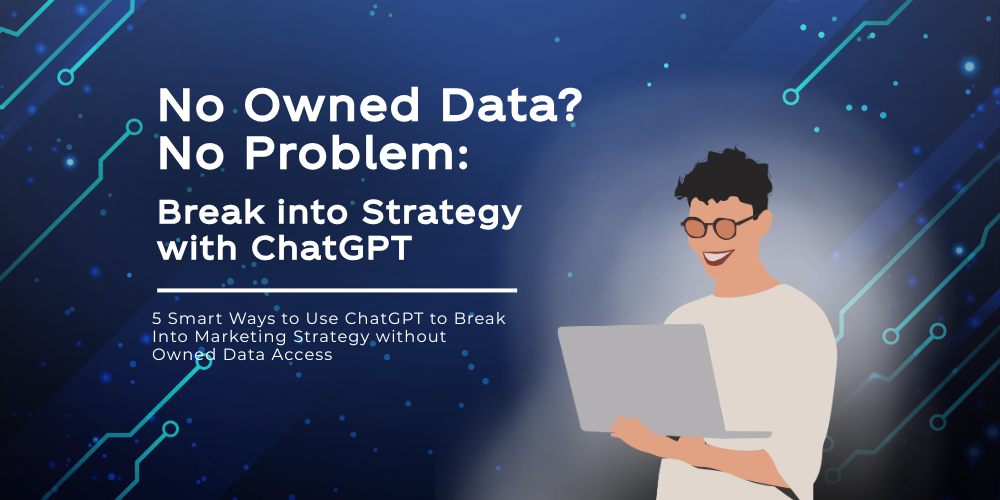5 Smart Ways to Use ChatGPT to Break Into Marketing Strategy Without Owned Data Access
By: Emily Zimmer, Sr. Brand Strategist at Avenue Z
One of the most common questions I get from students or young professionals is: How do I break into strategy when I’ve never worked with data or owned a platform login?
When building one of your first marketing strategies you’re often starting with only owned data, internal goals, and maybe some ad performance history. However, that’s only half the story. The other half? That comes from the world. Consumers. Competitors. Trends. Whitespace. And unless your first client is working with a full consumer insights team or has access to expensive tools like GWI or Mintel, you’re expected to fill in that half yourself—fast.
This is where AI, especially ChatGPT, can help. When used strategically, it becomes a supercharged research assistant, helping you accelerate strategic alignment, establish smart benchmarks, and test your thinking.
Below are five use cases where GPT can support stronger strategy development—especially when you’re early in your career, working on portfolio samples, or building a case for your pitches with limited resources.
⚠️ Heads up: ChatGPT isn’t a replacement for real data. Always cross-check your findings when not sourced with trusted sources like Statista, SimilarWeb, Pew, or platform-native tools. Use AI as a supplement to your work, not a shortcut past due diligence.
1. Instant Market & Category Research (to Understand the Playing Field)
Whether you’re diving into a new industry or building a campaign from scratch, understanding the broader market is essential. GPT can help you map emerging trends, consumer behaviors, and whitespace opportunities—fast.
Sample Prompt Template: “Conduct a market overview of the [industry] space in 2025, focusing on growth trends, emerging subcategories, audience behaviors, and top brands or disruptors. Cite sources or reference publicly available data where possible.”
Pro Tips:
- Ask follow-up questions like: “What is fueling growth in [subcategory]?” OR
“How has consumer behavior in this space shifted since 2022?” - Use live research mode (in GPT-4 with browsing enabled) by adding: “Use live research from the past 12 months to inform your answer.” (This prompts GPT to pull data from real-time sources where available.)
Use these scans to quickly build a directional POV on where the brand stands in its category and where the white space is—this is perfect to stakeholders or hiring manager that you understand the importance of being at pulse with the brands positioning.
2. Persona-Powered Strategy Testing (to Pressure-Test Messaging)
When you don’t have access to focus groups or audience testing, a custom GPT can help you pressure-test ideas by simulating your persona’s mindset. It’s a smart way to validate tone, messaging, and channel fit—especially for portfolio work or client concepts on a tight budget.
Sample Starter Prompt: “You are now [target persona]—a [demographic] who [key behavior or mindset]. You care about [core concern] and are active on [platform]. I’m going to share a few tactics—respond in character and tell me what resonates and why.”
Pro Tips:
- Build a detailed persona first: “Create a persona for a [demo] with [goal/mindset], including values, content habits, and objections.” Optional: send consumer research reports of the demographic with this prompt to guide it to align with your source or truth / benchmark.
- Then test concepts: “Would this persona respond better to urgency or emotional storytelling?” OR “Which of these headlines is stronger and why?”
This doesn’t replace real testing, but it’s a fast way to pressure-check if your thinking is directionally sound.
I recommend building a custom persona GPT by feeding it consumer insight reports or even social listening data to ground it in your baseline knowledge of that audienceS behavior, then ask it to supplement that with live research on that outlined consumer.
When throwing ideas by it, always ask it to explain what’s driving its response—that’s where the strategic gold is. This level of alignment stands out in portfolio work, shows sharp thinking to hiring managers, and earns buy-in from stakeholders.
3. Competitor & Positioning Scans (to Map the Landscape Fast)
Understanding how competitors show up is critical for strong positioning. Even without real-time research tools, your strategy doesn’t have to be uninformed—GPT can help you build a directional read and surface whitespace, tone, or channel insights.
Sample Prompt Structure: “Who are the top 5 direct and indirect competitors to [brand/product], and how are they positioning themselves? Include tone, channel usage, offers, and target segments.”
Pro Tips:
- (Warning – This is a hit or miss prompt) Ask for channel-specific insights: “What messaging are they using in paid ads on TikTok vs. Instagram?”
- If GPT doesn’t have access recent data, do a quick scan using:
- Meta Ad Library → View active ad copy/creatives
- TikTok Creative Center → Identify trending competitor ads
- SimilarWeb or BuiltWith → Uncover traffic sources and tech stack
- Meta Ad Library → View active ad copy/creatives
- Once you’ve gathered your own observations, plug them back into GPT: “Synthesize positioning insights from [Competitor A, B, C] and highlight differentiation opportunities.”
This helps you connect patterns and add depth to your takeaways. You’ll start spotting voice gaps, offer overlap, or underused channels— all great material for building positioning decks or creative brief samples.
4. Build Strategic Benchmarks (When You Don’t Have the Data Yet)
One of the hardest parts of working without platform access or historical client data is figuring out what good looks like. Whether you’re building sample strategy work or trying to guide a small business client, GPT can help you generate directional benchmarks rooted in data for KPIs, performance expectations, and campaign structures.
Sample Prompt Structure: “For a brand in the [category] targeting [audience], what are common success KPIs and performance benchmarks across [channels: Meta, YouTube, TikTok, Email]? Include ROAS ranges, engagement rates, and conversion metrics where applicable.”
Pro Tips:
- Ask for archetype-based benchmarks: “What does success look like for a mid-stage challenger brand in this category?” OR “What are typical Meta CTRs and CPA ranges for DTC brands targeting [audience]?”
- Try model campaign formats too: “What’s the standard structure of a product launch email for a wellness brand in 2024?”
This gives you a reference point when performance data is missing or goals are vague—whether you’re presenting strategy to a client or building your own case studies. A grounded strategy speaks the language of success early, even when you’re still learning what the benchmarks should be.
5. Synthesis & Insight Extraction (to Organize the Chaos)
Finally, strategy often lives in the messy middle through feedback, brainstorm notes, coffee napkins, scattered insights, etc. all needing to be shaped into something clear and actionable. GPT can connect the dots and turn chaos into concise, actionable direction.
Prompt Template:
“Here’s a summary of [focus group notes, survey responses, Slack messages, picture of copy napkin]. Identify 3 key themes and provide 1 recommended strategic action per insight.”
Pro Tips:
- Paste in up to 10,000 characters of unstructured input at once.
- Then prompt: “Cluster this into themes and summarize each one in no more than 2 sentences.” OR “What strategic action steps would you recommend based on this synthesis?”
This is especially helpful, in a pinch like in fast-paced post-campaign reviews, brainstorms, or when reconciling messy qualitative feedback into usable direction for creative, UX, or media teams. Use a GPT to store the feedback and connect the dots.
Strategy Is Part Math, Part Magic.
Strategy is rooted in data, and data isn’t always gated—for those breaking into the industry AI can be a powerful research tool to position your strategic expertise or level-up limited budget strategies.
It won’t do the strategic thinking for you, but it will help you explore ideas faster, connect dots, and sharpen your POV. Strategy is half the data you’re given, and half the data you distill from the world – GPT helps you access that second half—just don’t forget to bring your own perspective to the process.
The opinions expressed in this article are the writer’s own and do not reflect the views of Ad 2 or AAF.
This article is written by a volunteer writer for Ad 2 Orlando.

